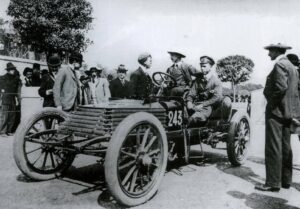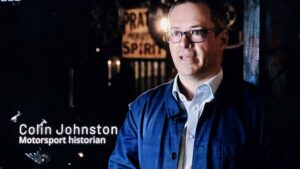
It’s 90 years since the greatest racers did battle in Belfast. 17th August 1929 saw ‘Tim’ Birkin’s blower Bentley challenge the works’ Mercedes-Benz of Rudi Caracciola, in the rain, for the Tourist Trophy.
There was a time when a Grand Prix car, a Le Mans racer, an endurance rally machine were one and the same. In that moment, the most storied marques and greatest racing drivers assembled in Belfast for the International Tourist Trophy. It was the 17th of August 1929. 90 years ago.
A field of 71 starters, the cream of European motorsport: Austin, Riley, Lea Francis… Bugatti, Bentley, Alfa Romeo, Mercedes-Benz. Overall win by handicap. Class wins and glory through balls-out, flat-chat road-racing over 400 miles.
Archie Frazer Nash lead a works team of baby Austin Sevens. John Cobb and Sammy Davis lined-up for Riley. Alfa Romeo had a phalanx of 1750 & 1500 6Cs, headed by Campari & Ivanowski. The Bugatti works sent a squad featuring Divo & ‘Williams’, recent winner of the 1er GP de Monaco. But the ‘prize fight’, at scratch on handicap, was between Sir Henry Birkin and Rudolf Caracciola. Battle rejoined between the 4.5-litre ‘Blower’ Bentley and the mighty 7-litre Mercedes-Benz SS.
Now, at this point I could insert some of the remarkable Mercedes-Benz public archive…
…or I could show you the Pathé news report…
But the best ‘Ripping Yarn’ report of the race is by Birkin’s ghost writer, Michael Burn in the book ‘Full Throttle’. The following is an extract from it:
“The chief threat to a Bentley victory was Caracciola’s 7-litre supercharged Mercedes. My 4 ½-litre Bentley, though supercharged too, stood little chance when we both started from scratch. The Alfas had a handicap of three laps, and the baby Austins of five. There were seventy-five entries. In such a crowd the slightest mistake would be calamitous, not so much for the probability of an accident as for the opening it would give to the cars thronging behind.
Full Throttle (1932)
That this danger was realized became apparent when thousands of people streamed into Belfast, expecting a race which only skill could win, and unskill was certain to make sensational. The morning of the race came with gray skies and an ominous forecast of worse weather ahead.
On the first lap Caracciola led, and a fight began between the Mercedes and Glen Kidston’s 6 ½-litre Bentley. Almost at once the rain began to fall, and soon a storm was sweeping over the course, drenching the drivers and sending Catherine-wheels of spray from the tires.
Bernard Rubin was the first to have a bad crash. He skidded, swerved wildly over the road, and in his own words, overturned slowly but gracefully. He tried to reach the switches to turn off the engine, but the engine had saved him the trouble. He and his mechanic lay underneath the car expecting another car to run into them at any moment. Their fear was luckily unfulfilled. Rain brought no relenting to Caracciola’s amazing speed-he continued to pass the grandstand at over 110 mph.
The water leaped off the hood and spurted in fountains around the wheels, but he seemed to have no trouble at all the corners. Glen stuck to him as bravely, and the crowds settled down under a rood of umbrellas to watch a wonderful race.
But at Bradshaw’s Brae, going at 90 mph, Glen skidded, could not hold the car, missed a telegraph pole by a miracle and crashed nose first over a ditch. Not even this could check the Mercedes, which lapped unfailingly at about 70, and then drew in to refuel.
After twenty laps it gained on the three leading Austins with their handicap of five laps, while Campari was fourth in an Alfa that started with three laps. My Bentley was running beautifully, and W.O., who was acting as my mechanic, was delighted. He saw that we had no chance of catching the Mercedes with its three extra litres on level terms but he was alert throughout the race as any permanent mechanic could have been.
At twenty-five laps, with only five more to go, one Austin had fallen back, and the lead of the other two had been much reduced. Campari was still third, and the Mercedes was gaining furiously from fourth. The honor of England was under the hoods of the two Austins; as they scuttled past the stands they were greeted with amazed cheers. Whenever Caracciola passed them they were quite hidden from the spectators and seemed to be moving backward.
Another rainstorm swept the road, but only at certain points, so that the surface was continually changing from dry to glassy. At Ballystockart Bridge, Clark, in an O.M., skidded., hit a hedge, and shot back into the middle of the road. Immediately a breakdown gang began to work to move it out of the way, and men ran with flags to signal danger to the cars behind. But they were to late. A Triumph could not stop in time, and the men, caught between this new danger and the wrecked O.M., had no hope of escape. Ambulance crews ran to their aid, but they could do nothing, and when I passed, there was little but the ruin of two carts and a frightened crowd to attest the tragedy.
Soon after this Caracciola passed Campari and roared in pursuit of the scurrying Austins. They were passed on the twenty-seventh lap after stopping to refuel. With three more laps to go, Campari was 54 seconds in front of Caracciola. On the twenty-ninth lap, at the beginning of the straight, Caracciola’s Mercedes flashed past Campari’s Alfa and settled the issue.
Campari was second, and the baby Austins had a great welcome as they tripped in third and fourth. I cannot give enough praise to the inspired driving of the winner. He averaged 72.82 mph, and I, who came in eleventh and second of those who started from scratch, was more than pleased with 69.01. Not for an instant did Caracciola falter. The rain was blinding and the roads never more slippery, but whenever he passed me at that terrific speed I felt no envy, only incredulity at his skill, his courage and the endurance of his car.
He broke records with ease under a deluge of rain, on road that was at times almost flooded, and never sacrificed the safety of others to his own ambition.”
Yes, you read that correctly. Birkin’s riding mechanic that wet day was none other than the patron, W.O. Bentley. Taking the opportunity and risk to feel, first-hand, the performance of Birkin’s privately-developed ‘blower’ Bentley… and to assess the threat of Mercedes-Benz.
Having seen the speed of Caracciola’s Mercedes, W.O. Bentley struck a deal with Birkin for the 1930 24h du Mans. To ensure a Bentley… *a British* win, Birkin would engage Rudi in battle from the off. As expected, under pressure both cars eventually failed – clearing the way for another Bentley victory.
But exactly 3 months later Birkin’s ‘blower’ Bentley project would have it’s day in the sun.
At Pau for the GP de l’ACF, Birkin stripped-off the mudguards & lights and after 247 miles of racing he was second at the flag. A Bentley, 2nd in the French Grand Prix… blowing it’s horn to pass the works Bugatti Grand Prix cars! Ettore Bugatti would declare it, “le camion plus vite du monde”.
Time was up though for Bentley, and ‘his boys’. The World – technology, the market – was moving on. Birkin went on to win 24h du Mans on an Alfa-Romeo – “for Italy”, as Mussolini’s congratulatory telegram stated – and was on a Maserati at Tripoli in 1933 when he burned his arm on the exhaust. The septic burn and latent malaria took his life 6 weeks later. He was 36 years old.
In Belfast that wet day in 1929, Rudi Caracciola was at the start-line of a remarkable decade, for him personally and for Mercedes-Benz. By the outbreak of war he would be considered one of the sport’s legends, have lead one of the greatest teams and raced the most remarkable cars ever created.
Rudi would return to Northern Ireland with the Mercedes team in 1955. After one last big crash he had retired from racing in 1952, and so was just a spectator at Mercedes-Benz’s final Tourist Trophy victory… itself an epic tale, for another day.
The great Caracciola passed away in 1959, he was 58 years old.


